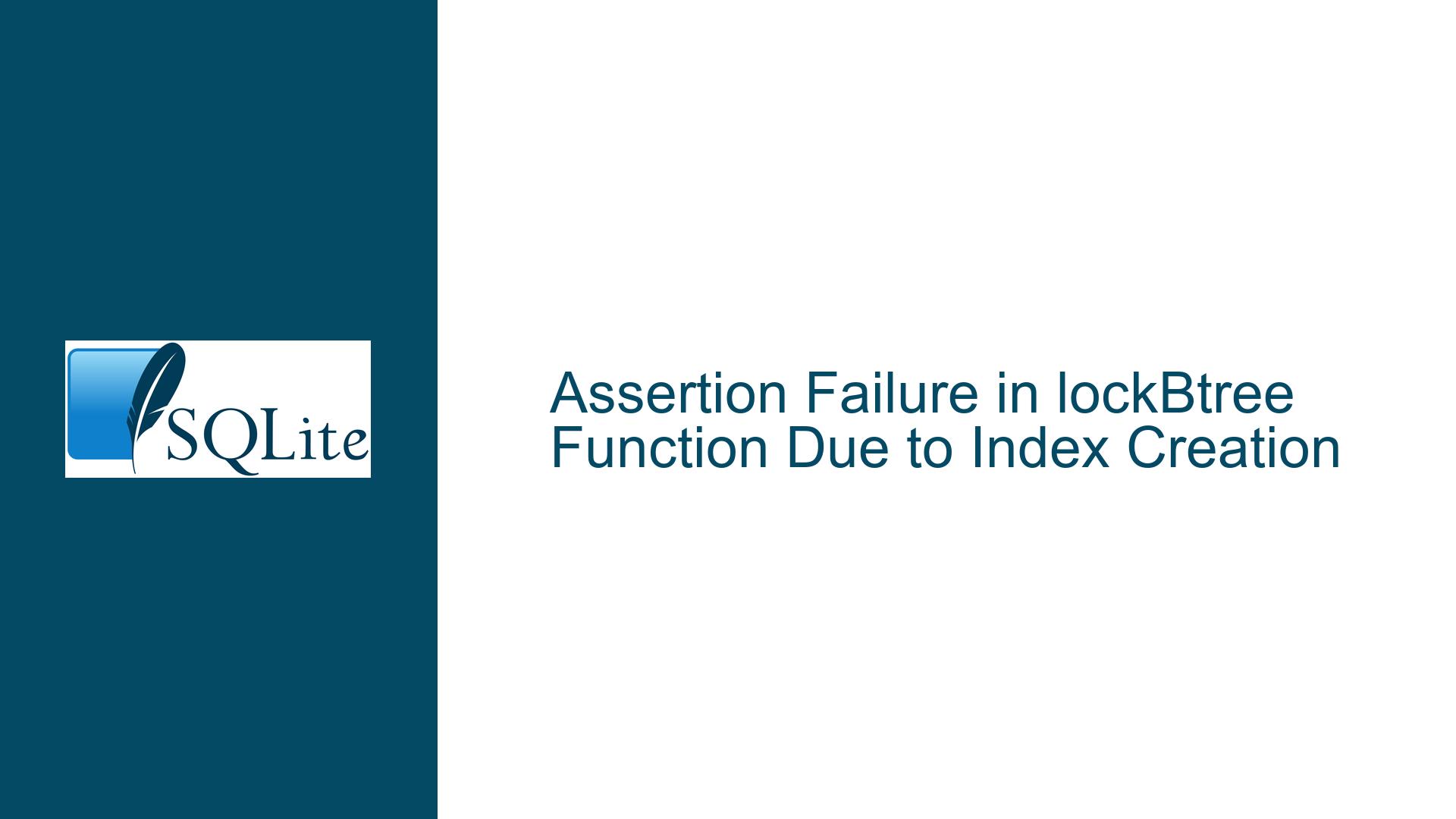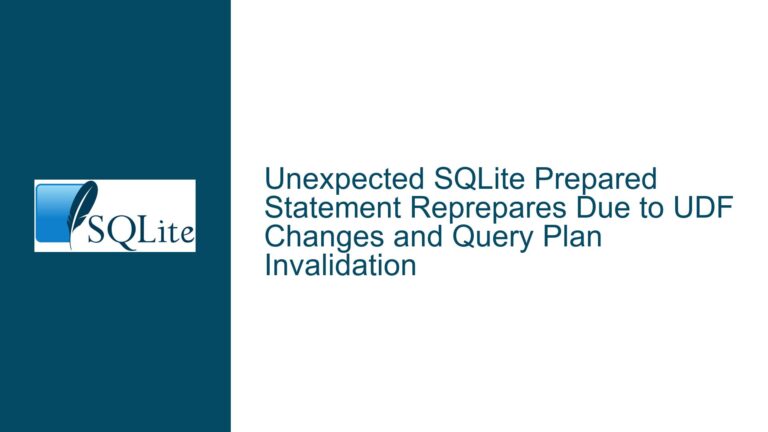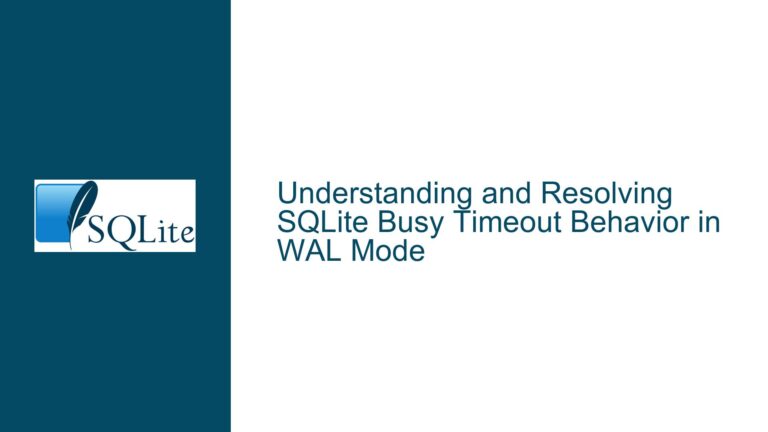Assertion Failure in lockBtree Function Due to Index Creation
Understanding the Assertion Failure in lockBtree During Index Creation
The core issue revolves around an assertion failure in the lockBtree function within SQLite, specifically triggered during the creation of an index. The assertion pBt->maxLeaf + 23 <= MX_CELL_SIZE(pBt) fails, indicating a violation of a critical constraint related to the B-tree structure. This failure occurs when executing a sequence of SQL commands, including setting a hard heap limit, creating an index, and tracing the database operations. The error message points to a mismatch between the maximum leaf size (pBt->maxLeaf) and the maximum cell size (MX_CELL_SIZE(pBt)) allowed by the B-tree structure.
The lockBtree function is a fundamental part of SQLite’s B-tree module, responsible for acquiring a lock on the B-tree structure to ensure thread safety during operations. The assertion ensures that the size of the leaf nodes in the B-tree does not exceed the maximum allowable cell size, which is a hard limit defined by the database page size and other internal constraints. When this assertion fails, it suggests that the B-tree structure has become corrupted or that the database is operating under conditions that violate its internal invariants.
The sequence of operations leading to the failure includes setting a small hard heap limit (PRAGMA hard_heap_limit=93000), which restricts the amount of memory SQLite can use. This restriction, combined with the creation of an index on a table (CREATE INDEX t ON e(0)), appears to push the database into a state where the B-tree constraints cannot be satisfied. The .trace command further complicates the scenario by enabling detailed logging, which may exacerbate memory pressure or expose latent issues in the database’s handling of constrained resources.
Investigating the Root Causes of the B-tree Constraint Violation
The assertion failure in lockBtree can be attributed to several potential causes, each of which interacts with the others in complex ways. The primary cause is likely related to the combination of a small hard heap limit and the creation of an index, which places significant demands on the database’s memory and storage structures. However, deeper analysis reveals additional contributing factors.
1. Hard Heap Limit Constraint: The PRAGMA hard_heap_limit=93000 command restricts SQLite’s memory usage to approximately 93 KB. This is an unusually low limit for most database operations, especially those involving index creation. When SQLite creates an index, it must allocate memory for the B-tree structure, including internal nodes and leaf nodes. The hard heap limit may force SQLite to use suboptimal memory management strategies, leading to fragmentation or insufficient space for the B-tree nodes. This, in turn, can cause the maxLeaf value to exceed the allowable cell size, triggering the assertion failure.
2. Page Size Configuration: The PRAGMA page_size=1024 command sets the database page size to 1 KB. While this is a valid configuration, it interacts with the hard heap limit in ways that may not be immediately obvious. Smaller page sizes reduce the amount of data that can be stored in each B-tree node, increasing the number of nodes required to store the same amount of data. This increases the overhead of the B-tree structure and may exacerbate the effects of the hard heap limit. Additionally, the MX_CELL_SIZE(pBt) calculation is influenced by the page size, and a mismatch between the page size and the heap limit can lead to violations of the B-tree constraints.
3. Index Creation Mechanics: The CREATE INDEX t ON e(0) command attempts to create an index on a table e using the expression 0. This is an unusual operation, as it creates an index based on a constant value rather than a column or expression that varies across rows. Such an index is unlikely to be useful in practice and may confuse SQLite’s query planner or index creation logic. The creation of this index may also place additional strain on the B-tree structure, particularly under memory-constrained conditions.
4. Debug Build and Tracing: The use of a debug build (--enable-debug) and the .trace command introduces additional overhead and complexity. Debug builds include extra checks and logging that can slow down execution and increase memory usage. The .trace command enables detailed logging of database operations, which may further strain the limited memory resources. These factors combine to create an environment where subtle issues in SQLite’s B-tree implementation are more likely to surface.
Resolving the Assertion Failure and Preventing Future Occurrences
To address the assertion failure in lockBtree and prevent similar issues in the future, a multi-faceted approach is required. This involves adjusting the database configuration, modifying the query sequence, and understanding the underlying mechanics of SQLite’s B-tree implementation.
1. Adjusting the Hard Heap Limit: The most immediate fix is to increase the hard heap limit to a value that provides sufficient memory for index creation and other operations. While the exact value depends on the specific workload and database size, a limit of several megabytes is typically sufficient for most use cases. For example, setting PRAGMA hard_heap_limit=1048576 (1 MB) provides a more reasonable memory budget. If memory constraints are unavoidable, consider optimizing the database schema and queries to reduce memory usage.
2. Revisiting the Page Size Configuration: The page size should be chosen based on the expected workload and storage requirements. For most applications, the default page size of 4 KB is a good balance between performance and storage efficiency. If a smaller page size is necessary, ensure that the hard heap limit is adjusted accordingly to accommodate the increased overhead of the B-tree structure. Additionally, consider using the PRAGMA auto_vacuum setting to manage free space more effectively.
3. Optimizing Index Creation: The index creation command CREATE INDEX t ON e(0) should be reviewed and modified to ensure it serves a meaningful purpose. If the intention is to create an index on a specific column or expression, update the command accordingly. For example, CREATE INDEX t ON e(column_name) creates an index on a specific column, which is more likely to be useful in queries. If the index is unnecessary, consider removing it to reduce the strain on the database.
4. Debugging and Tracing Considerations: While debug builds and tracing are valuable tools for diagnosing issues, they should be used judiciously in production environments. If the assertion failure only occurs in debug builds, it may indicate a latent issue that is masked in release builds. In such cases, consider reproducing the issue in a release build with additional logging enabled. Use the .trace command sparingly and only when necessary to avoid unnecessary overhead.
5. Understanding B-tree Constraints: A deeper understanding of SQLite’s B-tree implementation can help prevent similar issues in the future. The MX_CELL_SIZE(pBt) constraint is derived from the page size and other internal parameters, and it represents the maximum allowable size for a cell in the B-tree. Ensuring that the database schema and queries respect these constraints is critical for maintaining the integrity of the B-tree structure. Review the SQLite documentation and source code to gain insights into these constraints and how they interact with other database operations.
6. Testing and Validation: After implementing the above changes, thoroughly test the database to ensure the assertion failure no longer occurs. Use a combination of unit tests, integration tests, and stress tests to validate the changes under various conditions. Pay particular attention to scenarios involving low memory, small page sizes, and complex index creation operations. If possible, automate these tests to catch regressions early in the development cycle.
By addressing the root causes of the assertion failure and implementing the recommended fixes, you can ensure the stability and performance of your SQLite database. This approach not only resolves the immediate issue but also provides a foundation for preventing similar problems in the future.






